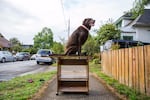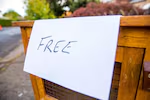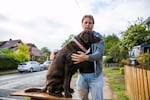Why do people in Portland leave their useless junk on the side of the road?
That question hit me maybe the third time I saw a soggy box full of old board games, or children’s clothes or a dilapidated couch on a Portland sidewalk.
On Sept. 10, Reddit user 'Blastosist' asked the Portland subreddit why people put "useless broken s--- out on the corner instead of disposing of it."
Good question, Blastosist.
The top reply was from ‘humanclock,’ who is actually Craig Giffen, a web developer from Yakima now living in Southeast Portland.
Giffen has become Portland's "free crap" chronicler by posting pictures of his dog, Ms. Freddie, next to, on and sometimes in Portland's notorious free piles on sidewalks, roadsides and lawns — tagging each post with #pdxfreecrap.
“It was just so funny how I could get her to jump up on a random couch in the middle of nowhere, so it was beyond funny,” Giffen said on a walk one cool September Saturday. “I just kept finding interesting garbage.”

Ms. Freddie poses on top of a discarded end table.
Bradley W. Parks / OPB
The Foster-Powell neighborhood where Giffen lives appears to be an area in transition. Moving trucks abound. There are houses being refurbished or remodeled.
Free piles are partly a product of that change, but also the effort to waste less.
“There’s definitely a desire to re-use something, not to landfill something,” said Stephanie Rawson, who manages Oregon Metro’s Regional Illegal Dumping program, or RID.
RID employs three crews that serve the Metro region by identifying and cleaning illegal dumps. The line between an illegal dump and a free pile, however, is murky. It’s largely up to the crews to decide.

A cabinet with the familiar "free" sign in Portland's Foster-Powell neighborhood.
Bradley W. Parks / OPB
Free piles have been part of Portland for a long time, so “maybe we’re numb to it,” Rawson said.
Generally, if free piles are well-maintained and not left out for inordinate amounts of time, they’re OK.
“Once the box has been torn apart, it’s lost its purpose,” Rawson said.
Metro offers a list of resources for properly disposing of and/or recycling unwanted goods. But the piles persist because people often take stuff from them.
“I do love a good free pile when I see one,” Rawson said. “There’s always something interesting in there.”

Craig Giffen preps Ms. Freddie for a portrait.
Bradley W. Parks / OPB
“It’s like a memory hole,” said Giffen, who has both left free piles and taken from them. “You can just put it out and you know it’s probably going on to a better life.”
Community-based programs like Buy Nothing are evidence of that desire to share resources and waste less.
Buy Nothing started in Bainbridge Island, Washington, and now has chapters in neighborhoods across the globe. It's based on the idea that there is enough stuff in our own communities that we hardly need to buy anything — and enough need for stuff to never throw anything in the garbage.
More than that, it's about building relationships in our own communities. That's according to Sondra Blair and Erin Frank, two of three administrators of the Foster-Powell Buy Nothing chapter.
“Quite a few people build lasting friendships through Buy Nothing,” Blair said.
“That’s actually how Sondra and I met,” Frank added.
Their chapter has shared everything from cars to use as shuttles for community programs to clothes and home goods for families recovering from house fires.
Facebook typically fuels Buy Nothing groups, serving as a sort of community bulletin board.
“I feel like this day and age people are so disconnected from each other,” Blair said. “We’re using Facebook, we’re using this technology that can be so isolating to bring people together in real life.”
Free piles seem like they’re here to stay, both in their soiled sidewalk form and their souped up social media form.
For Blair and Frank, free stuff has connected them to the community in which they live.
“It’s amazing to watch the community go into their own homes and give,” Frank said.
It’s sort of the same for Giffen, who has more than six years’ worth of #pdxfreecrap pictures to share with the world. They go all the way back to when Ms. Freddie was a puppy.
He said he’ll keep posting them as long as Freddie’s around.
As we walked, we came upon an inviting free pile next to new piping waiting to go underground. Under some wet clothes (it had recently rained) and a musty edition of Trivial Pursuit was a little ‘F’ button attached to a hook.
“‘F’ for Freddie,” he said.
Giffen hung it on the clip of Ms. Freddie’s collar and took her picture.

Craig Giffen takes a picture of his dog, Ms. Freddie, wearing her new, free necklace.
Bradley W. Parks / OPB
